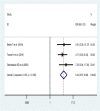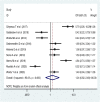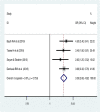Effect of Preterm Birth on the Risk of Adverse Perinatal and Neonatal Outcomes in Ethiopia: A Systematic Review and Meta-Analysis
- PMID: 34907788
- PMCID: PMC8802133
- DOI: 10.1177/00469580211064125
Effect of Preterm Birth on the Risk of Adverse Perinatal and Neonatal Outcomes in Ethiopia: A Systematic Review and Meta-Analysis
Abstract
Despite remarkable progress in the reduction of under-five mortality, the rate of perinatal and neonatal mortality is still high especially in developing countries. The adverse outcome associated with preterm birth is one of the major public health challenges in Africa. However, there are limited and inconsistent studies conducted on the effect of preterm birth on adverse perinatal and neonatal outcomes in Ethiopia. Therefore, this systematic review and meta-analysis aimed to investigate the association between preterm birth and its adverse perinatal and neonatal outcomes in Ethiopia. We systematically searched several electronic databases like PubMed, Web of Science, SCOPUS, CINAHL, Google Scholar, African Journals Online databases and Science Direct. All identified observational studies were included. The I1 statistics were used to assess the heterogeneity among the studies. A random-effects model was computed to estimate the pooled effect of preterm birth on adverse perinatal and neonatal outcomes. Thirty-three studies with a total of 20 109 live births were included in the final meta-analysis. Our meta-analysis showed that preterm birth increased the odds of perinatal mortality by 10-folds [POR = 9.56 (95% CI: 5.47, 19.69)] and there was a 5.44-folds risk of stillbirth [Odds Ratio = 5.44 (95% CI: 3.57, 8.28)] among women who gave birth before 37 weeks of gestation. In addition, preterm birth was significantly associated with neonatal hypothermia [OR=3.54 (95% CI: 2.41, 5.21)], neonatal mortality [OR= 3.16 (95% CI: 1.57, 6.34). The sub-group analysis of this meta-analysis showed that there was an increased risk of neonatal sepsis [OR=2.33 (95% CI: 1.15, 4.71)] among preterm babies. Preterm births significantly increased the risk of adverse perinatal and neonatal outcomes in Ethiopia. Therefore, scale-up strategies and improving the quality of maternal and child health care providers should be an area of intervention to reduce adverse outcomes associated with preterm birth. The Federal Ministry of Health and concerned bodies should work towards the prevention of preterm birth and its adverse outcomes.
Keywords: Ethiopia; adverse outcomes; meta-analysis; perinatal mortality; preterm birth.
Conflict of interest statement
Figures






Similar articles
-
Is preterm birth associated with intimate partner violence and maternal malnutrition during pregnancy in Ethiopia? A systematic review and meta analysis.Heliyon. 2021 Oct 6;7(10):e08103. doi: 10.1016/j.heliyon.2021.e08103. eCollection 2021 Oct. Heliyon. 2021. PMID: 34926844 Free PMC article.
-
The effects of completion of continuum of care in maternal health services on adverse birth outcomes in Northwestern Ethiopia: a prospective follow-up study.Reprod Health. 2022 Oct 8;19(1):200. doi: 10.1186/s12978-022-01508-5. Reprod Health. 2022. PMID: 36209163 Free PMC article.
-
Determinants of birth asphyxia among preterm newborns in Ethiopia: a systematic review and meta-analysis of observational studies protocol.Syst Rev. 2022 Feb 19;11(1):30. doi: 10.1186/s13643-022-01905-8. Syst Rev. 2022. PMID: 35183266 Free PMC article.
-
Epidemiology of preterm birth in Ethiopia: systematic review and meta-analysis.BMC Pregnancy Childbirth. 2020 Sep 29;20(1):574. doi: 10.1186/s12884-020-03271-6. BMC Pregnancy Childbirth. 2020. PMID: 32993555 Free PMC article.
-
Perinatal mortality and its association with antenatal care visit, maternal tetanus toxoid immunization and partograph utilization in Ethiopia: a meta-analysis.Sci Rep. 2021 Oct 4;11(1):19641. doi: 10.1038/s41598-021-98996-5. Sci Rep. 2021. PMID: 34608180 Free PMC article.
Cited by
-
Association Between Preterm Birth and Fulfillment of Desired Permanent Contraception.Matern Child Health J. 2025 Mar;29(3):396-404. doi: 10.1007/s10995-025-04063-0. Epub 2025 Jan 29. Matern Child Health J. 2025. PMID: 39878863
-
Predictors of neonatal mortality among neonates admitted to the neonatal intensive care unit at Hawassa University Comprehensive Specialized Hospital, Sidama regional state, Ethiopia.BMC Pediatr. 2024 Apr 3;24(1):237. doi: 10.1186/s12887-024-04689-z. BMC Pediatr. 2024. PMID: 38570750 Free PMC article.
-
Neonatal sepsis and its predictors in Ethiopia: umbrella reviews of a systematic review and meta-analysis, 2023.Ann Med Surg (Lond). 2023 Dec 11;86(2):994-1002. doi: 10.1097/MS9.0000000000001619. eCollection 2024 Feb. Ann Med Surg (Lond). 2023. PMID: 38333239 Free PMC article. Review.
References
-
- Murray CJ, Vos T, Lozano R, Naghavi M, Flaxman AD, Michaud C, et al. Disability-adjusted life years (DALYs) for 291 diseases and injuries in 21 regions, 1990-2010: A systematic analysis for the Global Burden of Disease Study 2010. Lancet. 2012;380:2197-2223. - PubMed
-
- Liu L, Johnson HL, Cousens S, Perin J, Scott S, Lawn JE, et al. Global, regional, and national causes of child mortality: An updated systematic analysis for 2010 with time trends since 2000. Lancet. 2012;379:2151-2161. - PubMed
-
- Oza S, Cousens SN, Lawn JE. Estimation of daily risk of neonatal death, including the day of birth, in 186 countries in 2013: a vital-registration and modelling-based study. Lancet Global Health. 2014;2(e635–44):e635-44. - PubMed
Publication types
MeSH terms
LinkOut - more resources
Full Text Sources

